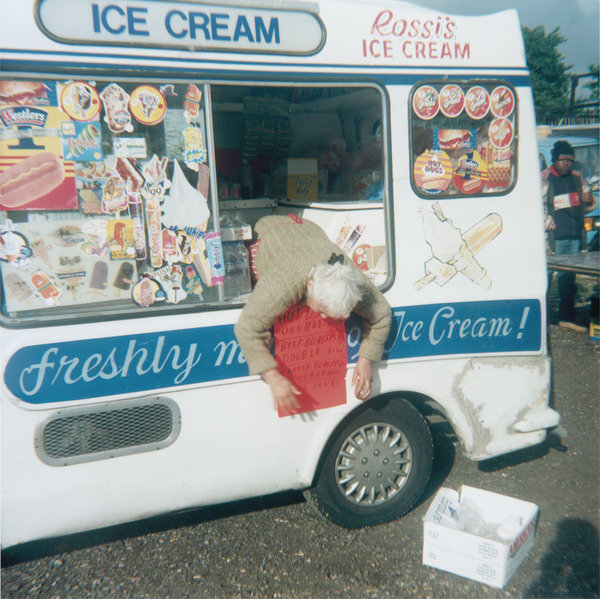Stephen Gill
dal 5/5/2015 al 26/6/2015
Segnalato da
5/5/2015
Stephen Gill
Christophe Guye Galerie, Zurich
Buried flowers coexist with disappointed ants. The artist uses the medium of photography in an unconventional way, in order to not only document a place and its inhabitants but to also comprehend them affectively.

The
British
p hotographer
Stephen
Gill
(b.1971,
UK)
uses
the
medium
of
photography
in
an
unconventional
way,
in
order
to
not
only
document
a
place
and
its
inhabitants
but
to
also
comprehend
them
affectively.
For
14
years
the
Hackney
borough
in
East
London
p rovided
t he
object
of
h is
photographic
research.
With
his
experimental
approach
he
h as
succeeded
in
capturing
the
genius
loci
in
a
manner
t hat
is
touching
and
s imultaneously
startling.
His
playful
handling
of
photography
breaks
with
traditional
concepts
of
mimetic
precision
and
technical
perfection:
by
burying
his
photographs
in
the
ground
or
soaking
them
in
a
p ond,
he
places
them
in
touch
with
the
essence
of
the
elemental
and
thus
invests
them
with
a
new
credibility
and
a
poetic
dimension.
In
its
retrospective,
the
C hristophe
Guye
Galerie
is
showing
highlights
from
the
years
2004
to
2012,
during
which
Stephen
Gill
created
his
sensational
series
“Hackney
Wick”,
“Hackney
Flowers”,
“Buried”,
“Coexistence”,
“Talking
to
Ants”
and
“A
Series
o f
D isappointments”
a nd
gained
himself
a
secure
place
in
contemporary
photography.
n
2002
a
Sunday
o uting
happened
to
lead
Stephen
Gill
to
Hackney
Wick,
a
poor
area
inhabited
primarily
by
immigrants:
a s
a
diverse
sociotope,
it
immediately
fascinated
him.
At
the
local
flea
market
on
that
same
day,
Stephen
Gill
purchased
a
cheap
plastic
camera
with
neither
focus
nor
exposure
controls,
so
that
he
could
use
it
to
document
the
neighbourhood
a nd
its
inhabitants.
He
spent
five
y ears
wandering
through
and
exploring
the
urban
area,
which
was
not
among
the
finest
a ddresses
in
London
and
had
no
tourist
attractions
to
offer
but
which
represented
a
kind
of
urban
niche,
where
people
and
a lso
animals
had
found
their
habitat.
The
series
“Hackney
Wick”
is
the
result
of
his
initial
a nd
gentle
acquainting
of
himself
with
a
place
whose
restructuring
with
a
v iew
to
the
2012
Olympic
Games
was
already
underway
a t
that
time.
ince
the
series
“Hackney
Flowers”,
a
photo
collage
made
up
o f
documentary
photos
as
well
as
flowers
a nd
plant
seeds
gathered
o n
location,
Stephen
Gill
has
no
longer
limited
himself
exclusively
to
shooting
photographs
a s
a
m eans
o f
collecting
evidence,
instead,
he
combines
traditional
photography
with
found
o bjects
in
order
to
reconnect
the
aseptic
photograph
with
the
nature
of
the
place.
The
continued
pursuit
of
this
philosophical
a pproach
led
to
the
series
“Buried”,
where
the
place
is
no
longer
incorporated
into
the
photograph
through
haptic
reminiscences:
on
the
contrary,
the
photograph
comes
into
contact
with
the
essence
of
the
place
by
being
buried
in
the
earth.
The
technique
of
photography
is
thus
expanded
to
comprise
an
uncontrollable,
organically
determined
process
of
decay
or,
a lternatively,
of
ripening.
The
series
“Coexistence”,
which
was
created
in
2010
in
the
town
of
D udelange
(Luxembourg),
points
in
the
same
direction.
There
Stephen
Gill
found
a
remnant
left
behind
by
the
a bandoned
steel
industry
in
the
form
o f
a
pond
that
had
once
been
used
to
cool
the
blast
furnaces.
He
resolved
to
link
the
organisms
contained
in
the
water
together
with
the
local
populace
that
had
previously
worked
in
the
steel
industry
in
terms
of
two
worlds
that
he
considered
comparable.
To
do
so,
he
created
portraits
of
the
people
in
their
homes
with
an
underwater
camera
that
he
had
previously
bathed
in
water
brought
by
him
in
pails
from
the
cooling
pond.
Finally
he
soaked
the
prints
in
the
pond
itself
in
order
to
contaminate
them
with
the
m icroorganisms
living
in
it,
thus
bringing
a bout
a
coexistence
of
biotope
a nd
sociotope.
The
most
recent
series
shown
in
the
Christophe
Guye
Galerie
bears
the
title
“Talking
to
Ants”.
These
works
were
once
a gain
shot
in
East
London
and
are
disconcerting
on
account
o f
their
distorted
proportions,
which
result
from
Stephen
Gill’s
placing
found
objects
a nd
insects
behind
the
lens.
Here
Stephen
Gill
integrates
life
directly
into
the
camera,
in
order
to
not
simply
objectively
“describe”
a
place
but
to
render
it
“tangible”.
The
c entral
a im
of
his
unorthodox
methods
is
to
communicate
a
sense
of
a
place.
To
do
so
he
uses
random
as
well
a s
deliberately
induced
elements
of
surprise
to
place
v iewers
in
a
state
o f
astonishment.
Stephen
Gill
possesses
a
highly
developed
sense
for
the
essential
that
often
dwells
within
the
unremarkable.
He
tracks
down
the
v itality
of
a
place
and
utilises
unorthodox
m ethods
to
v igorously
communicate
the
“indescribable”.
Image: Stephen GILL (*1971, Great Britain), Untitled, from the series 'Hackney Wick', 2005, Hand Print on C-Type Paper
Opening: Wednesday, 6th of May 2015, 6 – 8 p.m.
Christophe Guye Galerie
Dufourstrassse 31
8008 Zurich, Switzerland
Opening hours:
Monday - Friday 10 a.m. to 6 p.m.
Saturday 11 a.m. to 4 p.m.



